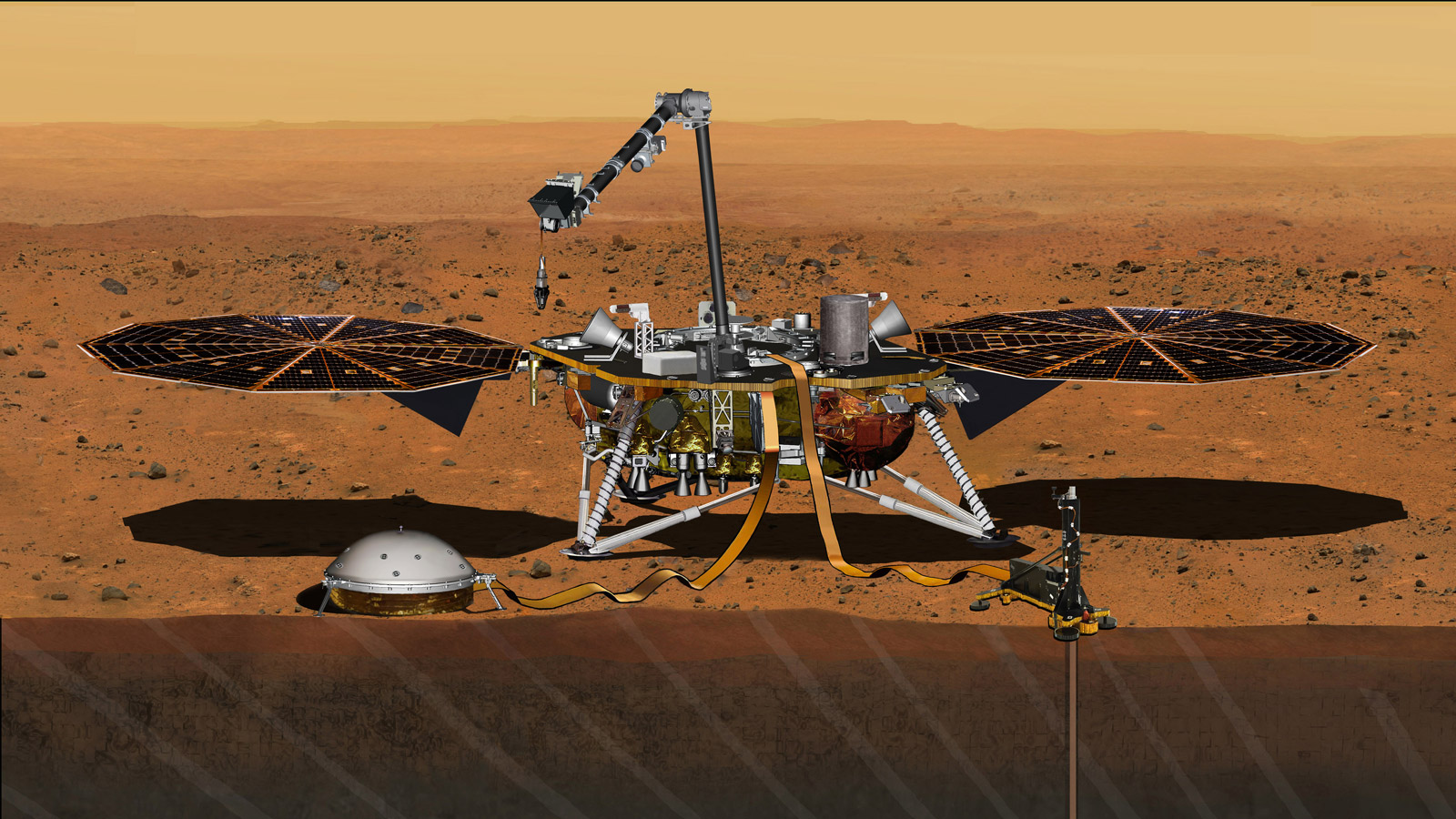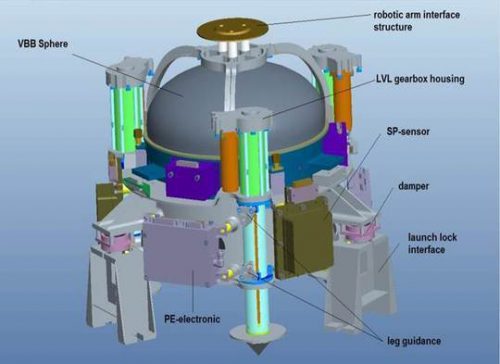NASA’s InSight mission to Mars will now go ahead as planned, it was announced today. After a delay due to a vacuum leak last December, with a launch originally slated for last March, it was unclear whether the mission would still be given the green light for a later launch. But now NASA has approved a launch for spring 2018.
NASA had targeted that time period before; final approval for the mission was given this week by the Science Mission Directorate. The launch period opens on May 5, 2018, with the landing scheduled for Nov. 26, 2018.
“Our robotic scientific explorers such as InSight are paving the way toward an ambitious journey to send humans to the Red Planet,” said Geoff Yoder, acting associate administrator for the Science Mission Directorate, in Washington. “It’s gratifying that we are moving forward with this important mission to help us better understand the origins of Mars and all the rocky planets, including Earth.”
It is welcome news for those who have been advocating for the mission despite the setback. Launch preparations were suspended last December when a leak was discovered in the Seismic Experiment for Interior Structure (SEIS) instrument. SEIS will look for “mars quakes”—extremely sensitive, it can measure ground movements as small as half the radius of a hydrogen atom. NASA’s Jet Propulsion Laboratory (JPL) will now be in charge of redesigning, developing, and qualifying the instrument’s evacuated container and the electrical feedthroughs which had failed previously. This procedure is known as a mission “replan.” Likewise, the Centre National d’Études Spatiales (CNES) in France will develop and deliver key sensors for SEIS, integrate the sensors into the container, and conduct the final integration of the instrument onto the spacecraft. The Heat Flow and Physical Properties Package (HP3) will be contributed to the science payload as well, by Germany.
Previous attempts to fix the leak problem in time for the earlier launch failed.
“The JPL and CNES teams and their partners have made a heroic effort to prepare the InSight instrument, but have run out of time given the celestial mechanics of a launch to Mars,” said JPL Director Charles Elachi. “It is more important to do it right than take an unacceptable risk.”
“It’s the first time ever that such a sensitive instrument has been built. We were very close to succeeding, but an anomaly has occurred, which requires further investigation. Our teams will find a solution to fix it, but it won’t be solved in time for a launch in 2016,” said Marc Pircher, Director of CNES’s Toulouse Space Centre.
The launch may have been delayed, but it is better than launching easier with a likely still-faulty instrument.
CNES President Jean-Yves Le Gall added, “This confirmation of the launch plan for InSight is excellent news and an unparalleled opportunity to learn more about the internal structure of the Red Planet, which is currently of major interest to the international science community.”
Saving the mission is great news, but it will increase costs. The original NASA budget for InSight was $675 million, but due to the delay and redesign, the cost of the mission will increase by $153.8 million. As it stands now, according to NASA, this will not affect any other current planetary missions, but it may result in fewer opportunities for new missions, from fiscal years 2017-2020. Conceivably, this could affect additional Mars missions, or future missions to the outer Solar System. One such mission which still has the go-ahead but may already be squeezed by funding cuts next year is the Europa Clipper. That is one of the most exciting missions on the table, since it will focus on searching for evidence of habitability or even life itself in Europa’s subsurface ocean.
InSight will be a unique Mars mission, focusing on the interior of the planet rather than the surface or atmosphere, as other missions have done. Scientists want to better understand how smaller rocky planets like Mars and Earth formed.
As Jim Green, director of NASA’s Planetary Science Division, noted, “We’ve concluded that a replanned InSight mission for launch in 2018 is the best approach to fulfill these long-sought, high-priority science objectives.”
There are several key mission objectives, including:
- Determine the size, composition, physical state (liquid/solid) of the Martian core
- Determine the thickness and structure of the Martian crust
- Determine the composition and structure of the Martian mantle
- Determine the thermal state of Mars’ interior
- Measure the magnitude, rate and geographical distribution of Mars’ internal seismic activity
- Measure the rate of meteorite impacts on the surface of Mars
The instruments on InSight include:
- Grapple – Mechanism at the end of the IDA that grips the instruments during deployment
- Heat Flow Probe – Hammering mechanism that pulls the temperature sensors down into the regolith
- HP3 – Heat Flow and Physical Properties Package, the heat flow experiment
- IDC – Instrument Deployment Camera, pointable medium-resolution camera
- IDA – Instrument Deployment Arm
- ICC – Instrument Context Camera, fixed wide-angle camera
- Pressure Inlet – Wind-shielded opening for pressure sensor
- RISE Antenna – X-band radio antenna for the Rotation and Interior Structure Experiment
- SEIS – Seismic Experiment for Interior Structure, the seismometer
- Tethers – Cables carrying electrical power, commands and data between the lander and instruments
- TWINS – Temperature and Winds for InSight, environmental sensors
- UHF Antenna – Antenna used for communication with orbital relay spacecraft
- WTS – Wind and Thermal Shield protecting the seismometer from the environment
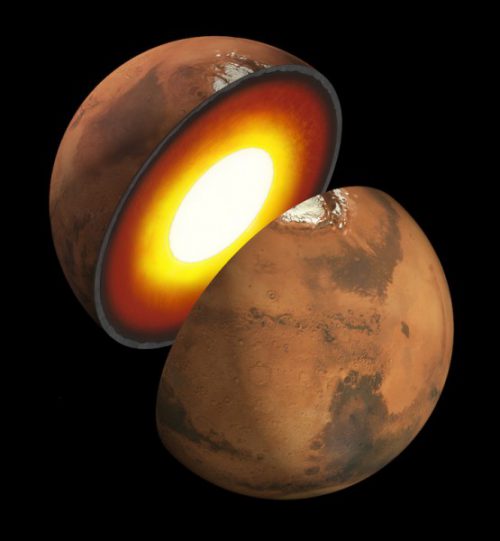
The InSight mission will help scientists better understand the interior structure of Mars. Image Credit: NASA/JPL-Caltech
“Learning about the interior structure of Mars has been a high priority objective for planetary scientists since the Viking era,” said John Grunsfeld, associate administrator for NASA’s Science Mission Directorate in Washington. “We push the boundaries of space technology with our missions to enable science, but space exploration is unforgiving, and the bottom line is that we’re not ready to launch in the 2016 window. A decision on a path forward will be made in the coming months, but one thing is clear: NASA remains fully committed to the scientific discovery and exploration of Mars.”
As summarized on the mission website:
“InSight’s primary objective will be to uncover how a rocky body forms and evolves to become a planet. Generally, a rocky body begins its formation through a process called accretion. As the body increases in size, its interior heats up and melts. As it subsequently cools and recrystallizes it evolves into what we know today as a terrestrial planet, containing a core, mantle and crust. While all of the terrestrial planets share similar structures and their bulk compositions are roughly the same as the meteoritic material from which they were formed, they are by no means uniform. Each of the terrestrial planets reached their current formation and structure through a process known as differentiation, which is poorly understood. InSight’s goal will be to solve the mystery of differentiation in planetary formation – and to bridge the gap of understanding that lies between accretion, and the final formation of a terrestrial planet’s core, mantle, and crust.
“InSight’s investigation of the Red Planet’s interior is designed to increase understanding of how all rocky planets, including Earth, formed and evolved,” said Bruce Banerdt, InSight Principal Investigator at NASA’s Jet Propulsion Laboratory (JPL) in Pasadena, Calif. “Mars retains evidence about the rocky planets’ early development that has been erased on Earth by internal churning Mars lacks. Gaining information about the core, mantle and crust of Mars is a high priority for planetary science, and InSight was built to accomplish this.”
InSight will be the first Mars mission to permanently place probes into the ground using its robotic arm, including the seismometer and a heat-flow probe. The seismometer will measure tiny marsquakes which cause microscopic movements of the ground, which will help scientists better understand the interior of Mars. The heat-flow probe measures heat coming from the planet’s interior and will hammer itself about 16 feet (3 to 5 meters) deep into the ground. Even the radio can be used to measure wobbles in the planet’s rotation and environmental instruments to monitor weather and changes in the magnetic field. Two cameras will survey the landscape, although being a lander and not a rover, InSight will not be able to go anywhere.
Design-wise, InSight is similar to the Mars Phoenix Lander, which landed near the Martian north pole in 2007. InSight re-uses a lot of the same technology from MPL.
Such delays have happened before, such as with the Curiosity rover mission.
“In 2008, we made a difficult, but correct decision to postpone the launch of the Mars Science Laboratory mission for two years to better ensure mission success,” said Jim Green, director of the Planetary Science Division in Washington. “The successes of that mission’s rover, Curiosity, have vastly outweighed any disappointment about that delay.”
That decision paid off in spades, and it seems likely that the same will be true for the InSight mission as well.
Quelle: AS
-
Update: 11.12.2016
.
3D-Simulation hilft dem Mars-Maulwurf
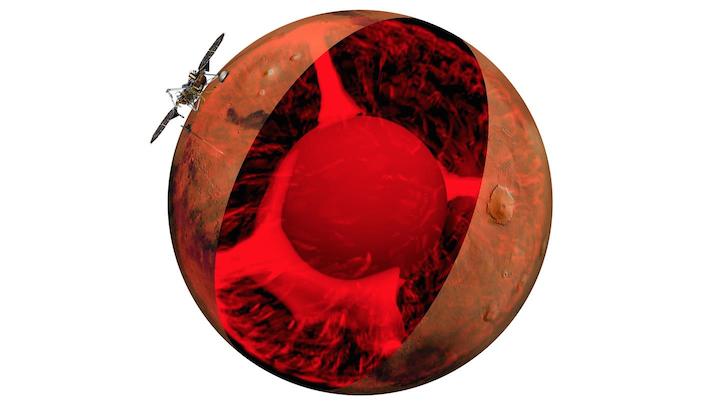
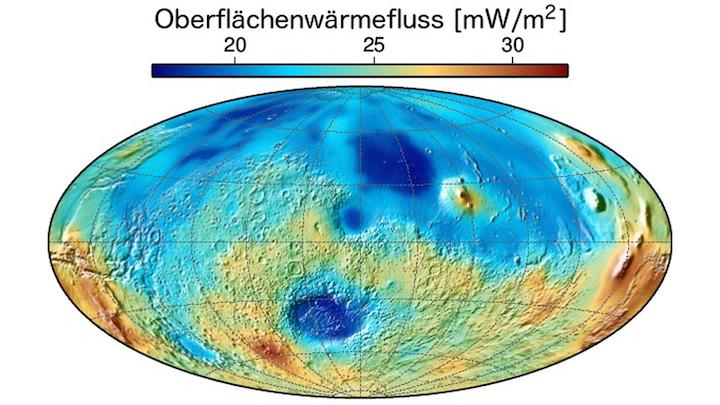
Gute Nachrichten für den "Maulwurf" HP3 (Heat Flow and Physical Properties Package), den das Deutsche Zentrum für Luft- und Raumfahrt (DLR) am 5. Mai 2018 mit der amerikanischen Mission InSight für Wärmefluss-Messungen zum Mars schicken wird: Die Landestelle in der Ebene "Elysium Planitia" hat sehr wahrscheinlich einen Wärmefluss, der durchschnittlich und somit repräsentativ für den Mars sein wird. Dies haben detaillierte Simulationen ergeben, die die DLR-Planetenforscherin Dr. Ana-Catalina Plesa mit ihrem Team erstellte: Das dreidimensionale Modell zeigt, dass der "Maulwurf", der zum ersten Mal Messungen in mehreren Metern Tiefe auf dem Mars durchführen wird, nicht auf extreme, verfälschende Anomalien stoßen wird. "Unser dreidimensionales Modell erfasst die Variationen und Abweichungen im Wärmefluss - der erloschene Vulkan Elysium Mons zum Beispiel wird die Messungen der InSight-Mission nicht beeinträchtigen", erläutert Dr. Ana-Catalina Plesa.
Basis der aufwendigen numerischen Simulationen, wie der Mars Wärme aus dem Inneren abgibt, sind Daten bisheriger Mars-Missionen zur Wärmeproduktion in den obersten Schichten der Mars-Kruste sowie Modellrechnungen zur Temperaturverteilung im Roten Planeten. "Die Simulationen sind die bisher beste Vorhersage der Verteilung des Wärmeflusses auf dem gesamten Planeten", betont Prof. Tilman Spohn, Direktor des DLR-Instituts für Planetenforschung und wissenschaftlicher Leiter des HP3-Experiments. "Sie werden uns auch helfen, die an der einen Stelle auf dem Mars gemessenen Werte anschließend in Relation zum gesamten Wärmeverlust des Planeten zu setzen." Die Messung eines durchschnittlichen Werts ist wichtig für die Wissenschaftler und die Aussagen, die sie mit den Daten über den Mars treffen wollen.
"Dampfmaschine" Mars
"Ein Planet ist eine Art Dampfmaschine - seine thermische Energie, umgesetzt in mechanische Arbeit, wirft Berge auf oder erzeugt Magnetfelder. Will man wissen, wie diese Wärmekraftmaschine funktioniert, muss man die Energiebilanz kennen", erläutert der Planetenforscher. "Dafür ist der Wärmestrom aus dem Inneren eine wichtige Messgröße." Würde die Landestelle von einem "Hotspot", einem sogenannten Plume, aufgeheizt, könnte der Wärmefluss an dieser Stelle doppelt so hoch sein wie auf dem übrigen Mars. Die Aussagen über den Roten Planeten würden damit nur für einen kleinen Teil der Oberfläche zutreffen.
Die Landestelle, an dem der InSight-Lander mit zwei Experimenten an Bord aufsetzen soll, liegt in einer ebenen Region in der nördlichen Tiefebene und nah am Rand zum südlichen Hochland, etwa 1500 Kilometer südlich von Elysium Mons. Ausgewählt wurde diese Region, weil ihr gegenüber, also auf der anderen Seite des Mars, das Gebiet mit den voraussichtlich meisten Mars-Erdbeben liegt und das Seismometer SEIS der französischen Raumfahrtagentur CNES so die Erschütterungen messen kann, die durch das Innere des Roten Planeten übertragen werden. Zudem ist die Ebene mit nur wenigen Felsen und Steinen günstig für eine sichere Landung. "Und mit unseren Simulationen steht jetzt fest, dass die Gegend auch gut für die Messungen des Wärmeflusses mit dem HP3-Instrument sind", sagt DLR-Wissenschaftlerin Dr. Ana-Catalina Plesa vom DLR-Institut für Planetenforschung. "Und mit diesen Daten wiederum können wir unsere Simulationen verifizieren und optimieren."
Wartezeit mit Nutzen
Die InSight-Mission sollte ursprünglich bereits im Frühjahr 2016 zum Mars starten. Allerdings wurden im Dezember 2015 technische Probleme bei dem französischen Seismometer festgestellt - die Mission wurde deshalb um zwei Jahre verschoben. Die Planetenforscher des DLR nutzen die unerwartete Wartezeit: "Wir haben ein weiteres, optimiertes Modell für den Maulwurf entwickelt und werden dieses im Frühjahr 2017 am DLR-Institut für Raumfahrtsysteme zusammenbauen lassen", erläutert der wissenschaftliche Leiter des Experiments, Prof. Tilman Spohn. "Der Maulwurf wird eine erhebliche mechanische Belastung überstehen und dabei eine Messkette mit Temperatursensoren mehrere Meter tief in den Marsboden ziehen müssen - das verbesserte Modell soll dies noch zuverlässiger und risikoärmer durchführen." Insgesamt ein Mars-Jahr und somit zwei Erdenjahre wird das Instrument Messwerte aus bis zu fünf Metern Tiefe liefern. Mit solch einer Langzeit-Messung können sowohl jahreszeitliche Temperaturunterschiede als auch Schwankungen im Tagesverlauf ausgeglichen werden.
Mars und Erde im Vergleich
Bisher wurden Temperaturmessungen im Boden eines Himmelskörpers lediglich bei den Apollo-Missionen durchgeführt: Damals hämmerten die Astronauten mit einem handbetriebenen Bohrer eine Sonde bis in drei Meter Tiefe. Der Maulwurf HP3 wird dies auf seiner Mission autonom, ohne Hilfe eines Astronauten, vornehmen. Mit den gewonnenen Daten können die Wissenschaftler auch auf die chemische Zusammensetzung des Mars schließen. "Vor allem können wir die beiden Wärmekraftmaschinen Mars und Erde miteinander vergleichen - einen Planeten mit Plattentektonik und einen ohne Plattentektonik", sagt DLR-Wissenschaftler Tilman Spohn. "Und aus Vergleichen lernt man immer."
Quelle: DLR
---
Update: 29.03.2017
.
InSight lander’s troubled seismometer passes major test

A balky interplanetary seismic instrument that ran into technical problems in 2015, forcing a two-year delay in the launch of NASA’s InSight lander to Mars, cleared a major test last week after engineers redesigned part of the sensor package, boosting confidence that the mission will be ready to blast off in May 2018.
Thomas Zurbuchen, head of NASA’s science mission directorate, said Tuesday that U.S. and French engineers completed the test of InSight’s Seismic Experiment for Interior Structure instrument last week. CNES, the French space agency, is responsible for providing the seismic instrument.
The seismometer consists of three sensors inside a vacuum enclosure the size of a volleyball. The container will shield the detectors from dust, wind and other hazards in the Martian atmosphere.
But the vacuum enclosure had persistent leaks as French engineers tried to ready the instrument for delivery to the United States in 2015, when InSight was scheduled for a month-long launch window in March 2016.
The InSight spacecraft, built by Lockheed Martin, the mission’s German-built heat flow probe, and the United Launch Alliance Atlas 5 booster were ready for the March 2016 launch window.
NASA officials elected to suspend the launch campaign in December 2015 when it became clear the SEIS instrument would not be ready in time. The seismometer is central to InSight’s primary science goals — studying the structure of Mars’s interior and unraveling how the solar system’s rocky planets formed.
The problem that cropped up in 2015 occurred as French engineers tried to feed electrical cables through ports on the enclosure and seal the container for flight, but the ground team could not overcome persistent leaks.
Engineers finished qualification testing of an engineering model of the redesigned enclosure a few months ago, and last week they completed vacuum leak testing of the flight model that will go to Mars, according to Bruce Banerdt, InSight’s principal investigator at NASA’s Jet Propulsion Laboratory.

JPL took over redesigning and testing the seismometer enclosure, while CNES remains in charge of developing the sensors themselves, integration of the sensors into the container, and final installation of the instrument on the lander.
The tests of the flight model of the enclosure checked its pressure integrity at room temperature and at the temperatures it will encounter at the Martian surface, Banerdt wrote in an email to Spaceflight Now.
He said the successful test builds confidence that InSight will meet its backup launch window next year, which opens May 5, 2018. Launch opportunities for Mars missions come about once every 26 months, when the positions of the planets enable a direct journey from Earth.
The seismometer instrument will be able to measure ground movements as small as half the radius of a hydrogen atom, NASA said, to sense minor shaking that may originate deep inside Mars. No mission has made a confirmed detection of “marsquakes” before, but instrumentation left behind by the Apollo astronauts discovered such tremors on the moon.
After reviewing the costs of the two-year delay, NASA announced in September that the InSight mission will go forward. InSight is one of the agency’s cost-capped Discovery-class interplanetary missions, selected in a competition among mission proposals in 2012.
NASA said the delay and rework will add $153.8 million to InSight’s cost. The mission’s budget from NASA was originally $675 million, but it will now exceed $800 million. Those figures do not include funding from CNES and DLR, the German space agency, for InSight’s two main instruments.
Once InSight lifts off on an Atlas 5 rocket next May from Vandenberg Air Force Base in California, the probe will cruise through the solar system for more than six months before plunging into the Martian atmosphere and braking to a rocket-assisted landing Nov. 26, 2018.
Based on the design flown on NASA’s Phoenix Mars mission that landed in 2008, InSight will use its robotic arm to place the seismic enclosure on the Martian surface to listen for quakes, and the heat probe will burrow to a depth of around 16 feet, or 5 meters, to measure the amount of heat escaping the planet’s interior.
Quelle: SN




